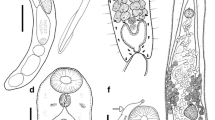Abstract
A new genus, Choanocotyle, is proposed to include two plagiorchiidan species. Choanocotyle elegans n. sp. is described from the small intestine of the freshwater turtles Chelodina expansa and Emydura macquarii. Choanocotyle nematoides n. sp. is described from the large intestine of E. macquarri. Descriptions are given of the adult, egg and miracidium, cercaria and metacercaria of each species. The two species have similar three-host aquatic life-cycles. A planorbid snail, Glyptophysa gibbosa, served as first intermediate host for both species in the laboratory. Isidorella newcombi was found naturally infected with C. elegans. Eggs were fully embryonated and infective when laid, but did not hatch until eaten by G. gibbosa. The intramolluscan prepatent period was 50 days for C. elegans and 35 days for C. nematoides. Metacercariae of C. elegans were recovered from experimentally infected snails ( G. gibbosa), tadpoles ( Limnodynastes peronii) and naturally infected crayfish ( Cherax sp.), while metacercariae of C. nematoides developed preferentially in the vertebral cartilage of L. peronii, but were also recovered from experimentally infected G. gibbosa, and field-collected leeches, Glossiphonia sp. Cercarial behaviour of each species is outlined briefly and observations are given on the host-parasite relationships of the metacercariae of each species. The disposition of Choanocotyle within the Plagiorchiida is discussed and it is concluded that it would be best placed in a new family, the Choanocotylidae.
Similar content being viewed by others
References
Bogitsh, B.J. (1959) A new species of Auridistomum (Trematoda: Auridistomidae) from snapping turtles of Georgia. Journal of Parasitology 45, 631–634.
Grabda-Kazubska, B. (1971) Main morphological characters in xiphidiocercariae armatae Lühe, 1909 and their taxonomic importance. In: Odening, K. (Ed.) Perspektiven der Cercarianforschung. Parasitologische Schriftenreihe, 21, 49–55.
Howell, M.J. (1970) Ingestion in two species of digenetic trematodes. Journal of Parasitology, 56, 391–392.
Jue Sue, L. & Platt, T.R. (1998) Redescription and life-cycle of Sigmapera cincta Nicoll, 1918 (Digenea: Plagiorchiidae) a parasite of Australian freshwater turtles. Systematic Parasitology.
Pearson, J.C. (1973) Revision of the subfamily Haplorchinae Looss, 1899 (Trematoda: Heterophyidae) II. Genus Galactosomum. Philosophical Transactions of the Royal Society London, Series B, Biological Sciences, 266, 341–477.
Yamaguti, S. (1971) Synopsis of digenetic trematodes of vertebrates. Tokyo: Keigaku Press, Vol. 1, 1,074 pp.; Vol. 2, 2,349 plates.
Yamaguti, S. (1975) Synoptical review of life histories of digenetic trematodes of vertebrates. Tokyo: Keigaku Press, 1,100 pp.
Rights and permissions
About this article
Cite this article
Sue, L.J. Description and life-cycle of two new species of Choanocotyle n. g. (Trematoda: Plagiorchiida), parasites of Australian freshwater turtles, and the erection of the family Choanocotylidae. Syst Parasitol 41, 47–61 (1998). https://doi.org/10.1023/A:1006074125118
Issue Date:
DOI: https://doi.org/10.1023/A:1006074125118




